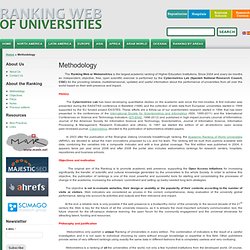

From bibliometrics to altmetrics. A changing scholarly landscape When future Science Citation Index founder Eugene Garfield first came up with the idea of journal impact factor in 1955, it never occurred to him “that it would one day become the subject of widespread controversy.”1 Today, techniques for measuring scholarly impact—traditionally known as bibliometrics —are well known for generating conflict and concern, particularly as tenure-track scholars reach beyond previously set boundaries of discipline, media, audience, and format.

From the development of more nuanced academic specialties to the influence of blogs and social media, questions about the scope of scholarly impact abound, even as the pressure to measure such impact continues unabated or increases. General resources. Les indicateurs de l’évaluation de la recherche : de l’impact factor à l’h-index.
Impact. Methodology. The Ranking Web or Webometrics is the largest academic ranking of Higher Education Institutions.

Since 2004 and every six months an independent, objective, free, open scientific exercise is performed by the Cybermetrics Lab (Spanish National Research Council, CSIC) for the providing reliable, multidimensional, updated and useful information about the performance of universities from all over the world based on their web presence and impact. History The Cybermetrics Lab has been developing quantitative studies on the academic web since the mid-nineties. Peer review.